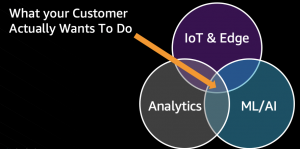AWS Public Sector Blog
Trends in IoT and beyond, powered by the cloud
 We’re in the midst of the information age and the Internet of Things (IoT) is at the center. What is IoT? It describes the billions of devices around the world that are connected to the internet, devices that can capture and analyze data and then perform an action based on that analysis.
We’re in the midst of the information age and the Internet of Things (IoT) is at the center. What is IoT? It describes the billions of devices around the world that are connected to the internet, devices that can capture and analyze data and then perform an action based on that analysis.
Whether it is an emerging IoT device, an innovative solution pivot, or a tried-and-true IoT application, a few things remain constant: we can look to leading examples from smart cities and healthcare to understand current and future uses, and securely deploying and managing devices is an absolute must.
Building smart cities with IoT
By harnessing the power of IoT, machine learning (ML), artificial intelligence (AI), and more, cities can realize their vision and deliver a better future for all. Key drivers in the creation of smart cities are the need to respond and act on data, attract people to a city by providing better services, and become environmentally aware and friendly. Successfully executing on these drivers requires data consolidation and integration, public-private partnerships, and the implementation of predictive analytics.
Amazon Web Services (AWS) Partners Contino and Vizalytics Technology worked with Transport for New South Wales (TfNSW) to develop dashboards that deliver near real-time insights and data-driven recommendations. TfNSW is now able to predict patronage numbers across the entire transport network, enabling the agency to better plan workforce and asset utilization and improve customer satisfaction. The solution is using ML to make real-time decisions and leveraging public-private partnerships to yield digital innovation.
One way we look toward these leading examples within cities is through the AWS City on a Cloud Challenge. The 2020 challenge is now live—and we’re looking forward to many great submissions from our partners and customers. You can also learn more about IoT for smart cities in the breakout session “Using the cloud to build a smart cities vision” at the AWS Public Sector Summit Online.
Healthcare is experiencing an IoT explosion
In the healthcare market segment, Business Insider reported that the IoT healthcare technology market will rise to $400 billion by 2022. Driving the uptick in IoT use is its ability to increase access to healthcare, conduct diagnostics remotely, and create holistic health views that allow for better diagnosing and decision making. But for IoT in healthcare, training and adoption take time and security and compliance is vital. What can we do with all the data?
Philips, an AWS Partner, is solving these issues through their HealthSuite Digital Platform (HSDP), built on AWS. HSDP offers a series of services to help its customers support legacy applications and develop innovative solutions. It also provides access and identity management, scalable IoT services, data management and analysis, and more. Ypsomed Delivery Systems, a manufacturer of injection devices used to dispense medication in clinical trials, adopted Philip’s HSDP to address the challenges of remote device management, global scale, and privacy and security regulations such as HIPAA and GDPR. Ypsomed reported that they accelerated their development and created their solution from scratch in five months by building on Philips HSDP on AWS.
Deploying IoT, securely
More IoT devices equals more vulnerabilities and the right compliance, governance, and device integrity are required. At AWS, security will always be our top priority. When it comes to security and IoT there are three things to consider:
- Availability: Get access when needed.
- Confidentiality: Meet compliance and governance requirements.
- Integrity: Trust the information the IoT device is reporting.
For example, Saildrone, an AWS Advanced Public Sector Partner and designer and manufacturer of wind and solar-powered ocean drones, recently completed the first successful autonomous circumnavigation of Antarctica, producing key insights into ocean and climate processes. Saildrone was able to achieve this by ensuring that the data from their vehicles was available, confidential, and trusted. Data from the Antarctic mission was sent back in real-time and stored in the AWS Cloud.
Twenty days after the mission was over, the high-resolution raw data was offloaded from the vehicles so that scientists and users could access and compare the data. Saildrone made the data open and available for download in NetCDF format from their custom data portal hosted on AWS, data.saildrone.com. NetCDF is a self-describing file type containing not only the data values but the related metadata necessary for interpretation. Saildrone has worked in close partnership with the scientific community for several years to ensure each vehicle’s sensors are properly calibrated and has performed several years of at-sea comparisons between Saildrone data and the established standards of ships and buoys.
Saildrone uses services like AWS IoT Core and AWS IoT Device Management. AWS IoT Core and AWS IoT Device Management are now available on AWS GovCloud (US), which many customers use to help with the security of IoT. Learn more about improving your organization’s security posture with AWS at the upcoming AWS Public Sector Summit Online on October 20.
Putting it all together
Last month, I spoke on the top three essential trends in IoT during IoT Slam ‘20 put on by the IoT Community. AWS is a proud sponsor of the IoT Community – the world’s largest and longest standing CxO community for senior business leaders and IoT practitioners. If you are interested in exploring IoT, please join the IoT Community or APN and consider the IoT competency. Learn more about our broad set of IoT partners with deep domain expertise and edge-to-cloud solutions built on AWS.